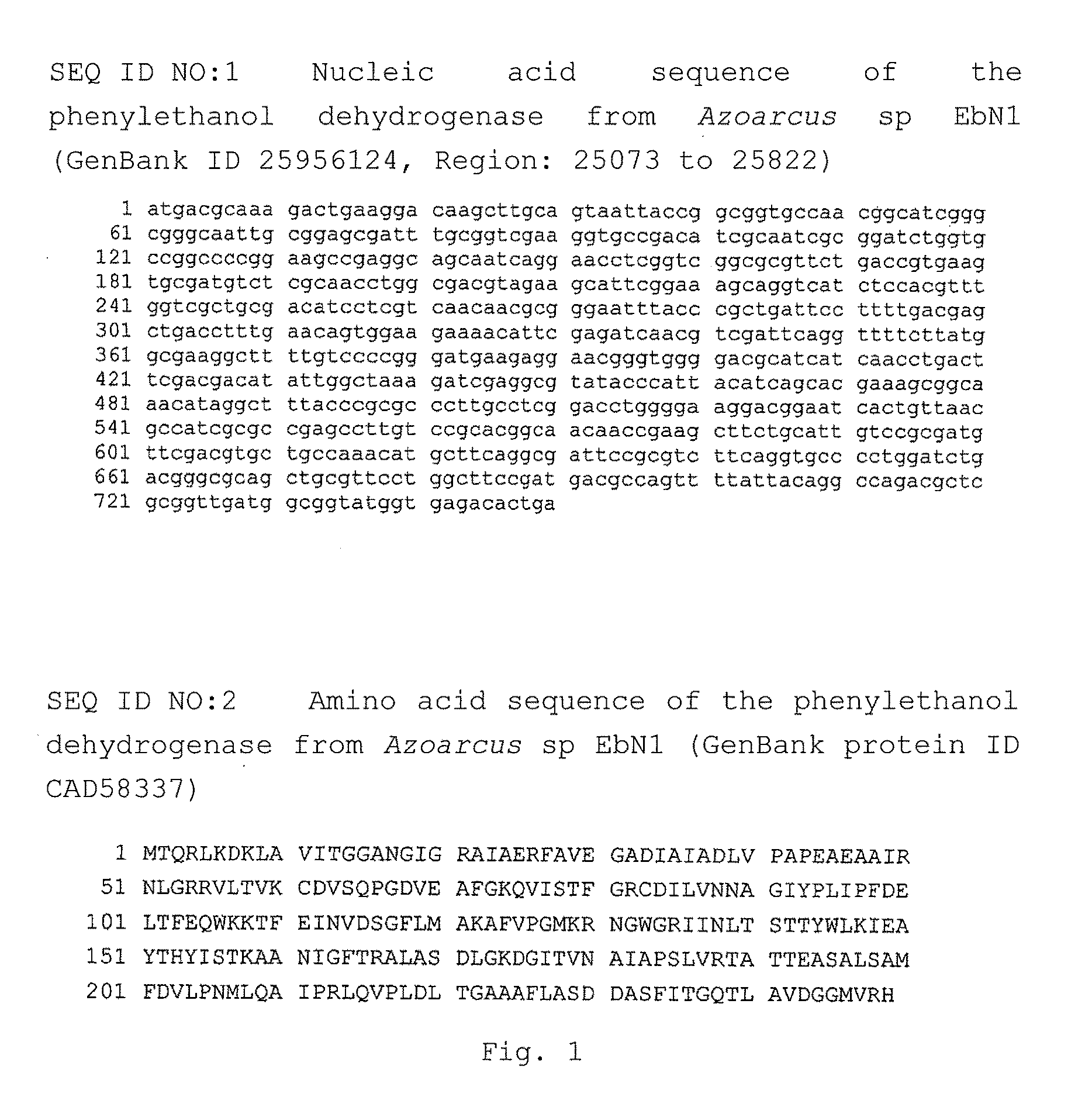Method for producing l-phenylephrine using an alcohol dehydrogenase of aromatoleum aromaticum ebn1 (azoarcus sp. ebn1)
a technology of aromatoleum aromaticum and alcohol dehydrogenase, which is applied in the field of producing l-phenylephrine using the alcohol dehydrogenase of aromatoleum aromaticum ebn1, can solve the problems of l-phenylephrine obtained that cannot be purified economically to a purity of at least 98% ee, and the product cannot be produced in sufficient purity as l-, so as to achieve high stereoselectivity
- Summary
- Abstract
- Description
- Claims
- Application Information
AI Technical Summary
Benefits of technology
Problems solved by technology
Method used
Image
Examples
example 1
Synthesis of HCAP, 2 (in Ethyl Acetate)
[0176]A 6000-ml Miniplant reactor with impeller stirrer, baffle, thermometer and dropping funnel is charged with 435.68 g (3.20 mol) of 3-hydroxyacetophenone in 410.11 g (12.80 mol) of methanol and 1200 ml ethyl acetate. At 20-30° C., with cooling, 691.05 g (5.12 mol) of sulfuryl chloride is added dropwise to this solution within 2 h. After the dropwise addition, the mixture is stirred for a further hour at room temperature. Then the mixture is hydrolyzed at room temperature with 1600 ml H2O and the resultant two-phase mixture is separated. The aqueous phase is extracted once more with 800 ml ethyl acetate. The methanol and the ethyl acetate are distilled from the combined organic phases by means of a distillation bridge. Simultaneously, 1880 ml isopropanol is added dropwise to the distillation sump. We obtain 2462.5 g of a 17.3% isopropanolic solution of the valuable product, which corresponds to a content of 426 g (2.51 mol). The yield is the...
example 2
Synthesis of HCAP, 2 (in Dichloromethane)
[0177]A 2000-ml Miniplant reactor with impeller stirrer, baffle, thermometer and dropping funnel is charged with 204.23 g (1.50 mol) of 3-hydroxyacetophenone in 192.24 g (6.00 mol) of methanol and 1050 ml of CH2Cl2. At 20-30° C. with cooling, 283.44 g (2.10 mol) of sulfuryl chloride is added dropwise to this solution within 2 hours. After the dropwise addition, the mixture is stirred for a further hour at room temperature. Then the mixture is hydrolyzed at room temperature with 400 ml H2O and the resultant two-phase mixture is separated. After phase separation, the methanol and the CH2Cl2 are distilled from the organic phase by means of a distillation bridge at normal pressure. Simultaneously, 880 ml of isopropanol is added dropwise at the same rate. We obtain 837.78 g of a 25.7% isopropanolic solution of the valuable product, which corresponds to a content of 215 g (1.26 mol). The yield is therefore 84%.
example 3
Synthesis of HCPE, 3
[0178]A ketone 2, prepared as in example 1 or 2, is reduced biocatalytically to R-3. For this, in a suitable stirred vessel, 1 mM MgCl2, 0.02 mM nicotinamide adenine dinucleotide (NAD) and 282 g isopropanol, which also serves as sacrificial alcohol for cofactor regeneration, are dissolved in 1.44 L aqueous potassium phosphate buffer (50 mM, pH 7). Cells of recombinant Escherichia coli (corresponding to 3.75 g bio dry weight), which overproduce a stereoselective dehydrogenase (E.C. 1.1.1.1), are used as catalyst. The production of a suitable biocatalyst is described in WO 2005 / 108590, example 1-3, to which reference is expressly made hereby. The aqueous phase is covered with 1.3 kg MtBE. 292.8 g of 2 (as isopropanolic solution) is added to the reaction mixture. The concentration of 2 in the reaction mixture should not exceed 50 mM. The reaction can be monitored by achiral or chiral chromatography.
[0179]After the reaction, the organic phase and the aqueous phase se...
PUM
 Login to View More
Login to View More Abstract
Description
Claims
Application Information
 Login to View More
Login to View More - R&D
- Intellectual Property
- Life Sciences
- Materials
- Tech Scout
- Unparalleled Data Quality
- Higher Quality Content
- 60% Fewer Hallucinations
Browse by: Latest US Patents, China's latest patents, Technical Efficacy Thesaurus, Application Domain, Technology Topic, Popular Technical Reports.
© 2025 PatSnap. All rights reserved.Legal|Privacy policy|Modern Slavery Act Transparency Statement|Sitemap|About US| Contact US: help@patsnap.com



